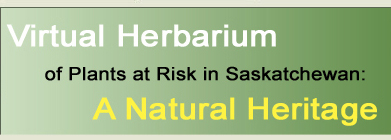
|

|

|

|

|

|

|
|
|
|
|
|
| Downingia laeta (Greene) Greene | Species Image Gallery (opens in a new window) |
||||||||||||||
| TAXONOMY | |||||||||||||||
| Family: | Campanulaceae | ||||||||||||||
| Genus: | Downingia | ||||||||||||||
| Species Synonyms: | none | ||||||||||||||
| Common Names: | calico-flower Great Basin calicoflower Great Basin downingia bright downingia |
||||||||||||||
| DISTRIBUTION | |||||||||||||||
| Canada: | southeastern Alberta - southwestern Saskatchewan | ||||||||||||||
| Saskatchewan: | southwestern Saskatchewan; Cypress Hills, Great Sand Hills - Rosetown | ||||||||||||||
| Ecoregion: | Cypress Upland, Mixed Grassland, Moist Mixed Grassland | ||||||||||||||
| HABITAT | |||||||||||||||
| Saskatchewan: | alkaline or saline mudflats, roadsides and cultivated field depressions | ||||||||||||||
| Associated Species: | awl-leaf mudwort, common spikerush, Engelmann’s spikerush, golden dock, longstem waterwort, narrowleaf dock, narrowleaf water plantain, spreading yellowcress | ||||||||||||||
| RARITY STATUS | |||||||||||||||
| Provincial
Status According to Harms (2003): |
Threatened |
||||||||||||||
| Nature Conservancy Status: | G5 S1S2 |
||||||||||||||
| Saskatchewan
Species at Risk Status: |
None |
||||||||||||||
| COSEWIC Status: | None |
||||||||||||||
| Calico-flower is threatened because it is rare in the province and is regionally restricted to two general regions of the province. This species is usually locally numerous within limited areas. | |||||||||||||||
| SPECIES DESCRIPTION | |||||||||||||||
| Height: | 5 – 15 cm | ||||||||||||||
| Roots: | fibrous | ||||||||||||||
| Stems: | annual, often reclining, branched, hairless, sometimes rooting at nodes | ||||||||||||||
| Leaves: | on the stem, alternate, sessile, 7 – 12 mm long, 2 – 4 mm wide, oblong to elliptic, falling off at time of flowering | ||||||||||||||
| Inflorescence: | flowers without stalks, in axils of upper leaves or bracts | ||||||||||||||
| Flowers: | sepals leaf-like, nearly distinct; petals irregular, 5-parted (2 lobes above, 3 below), not split, 4 – 7 mm long, not longer than sepals, white to pale blue or violet with darker blue veins, whitish throat spotted with yellow; anthers and filaments united to form cylinder around style, joined to the petals, 2 anthers bristle-tipped; ovary inferior, 1 – 2 cm long, looks like fattened stalk | ||||||||||||||
| Fruits: | capsule pod-like, 1-chambered | ||||||||||||||
| |||||||||||||||